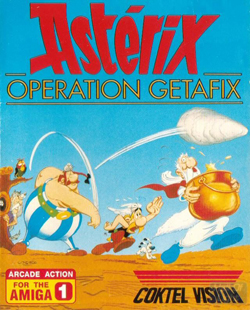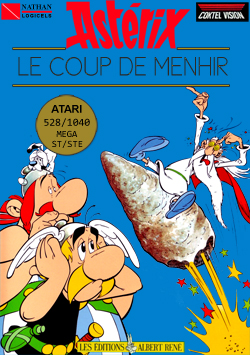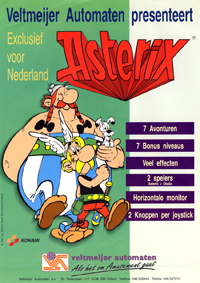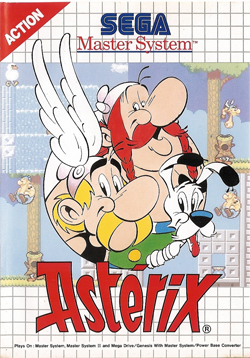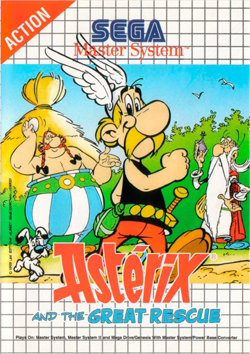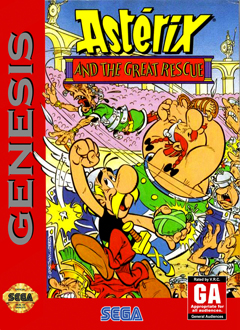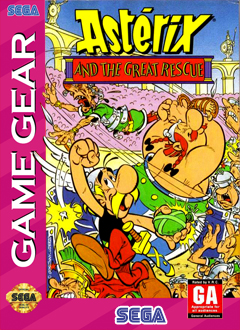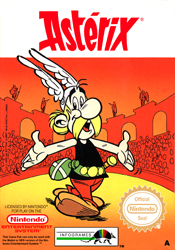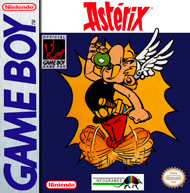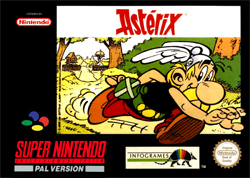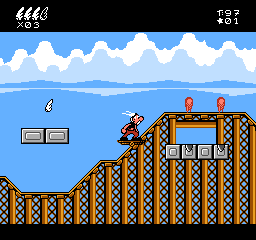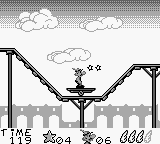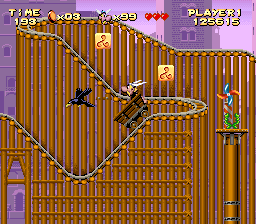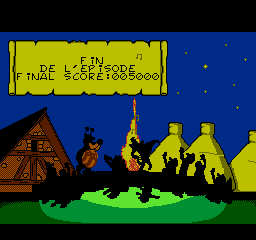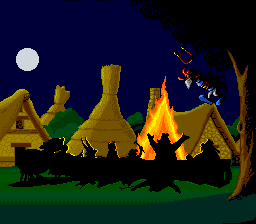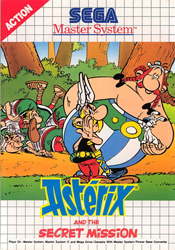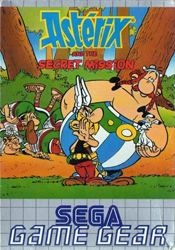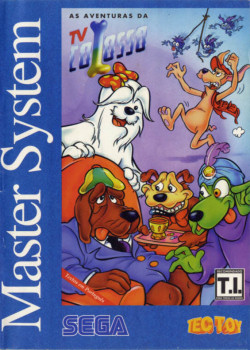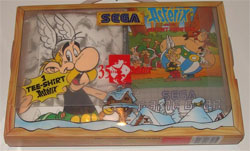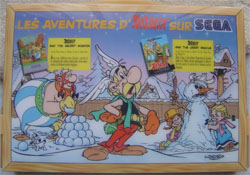
|
Page 1: |
Page 2: |
Page 3: |
Page 4: |
Page 5: |
|
Page 6: |
Page 7: |
Page 8: |
As the '90s approached, Nintendo had taken over the video game world with Sega being in close second. With games like Super Mario Bros. and Alex Kidd, platformers had seen a revolution and became the gameplay of choice across consoles and home computers in an attempt to cash in on the kids who yearned for the next mascot to jump onto enemies and collect coins. Coktel Vision would completely ignore this platformer movement and instead go back in time, back to their very first Astérix game released on the Thomson MO5.
Astérix: Le coup du menhir is more or less a updated version of Astérix et la Potion Magique. The premise is the same - you walk around to collect ingredients to a potion. In order to progress to one area you must find a specific item, which leads to backtracking through the woods and village. As you find various items, you have to go back into the village and test the combinations in Panoramix to see if it cures him. If it's wrong, you gotta go out in the world again and try over and over again. Everything is out to kill you, as you'll have to fend your way through Romans, wild boars, flying fish and other hazards. You also gotta be careful cause the ol' hunger meter is back so if you don't eat, it spells defeat.
Also like Astérix et la Potion Magique, the games story is based on a central plot point of an Astérix movie. This game is a video game tie-in to the cartoon that was released at the time under the same name where Panoramix has gone crazy due to an accident involving a menhir falling over him. Without Panoramix the village seems doomed and they put their faith on a traveler who recently came to town named Prolix. Astérix does not trust Prolix and decides along with Obélix to try to help Panoramix return to his old self. This leads to a great disconnect between Astérix and the other villagers, and the race is on to cure Panoramix before the Romans catch wind of the current situation and attack.
This game suffers from some very delayed and stubborn controls which turns nearly all actions in the game into a mess. It seems that it takes Astérix well over a second to respond to your input and when he finally does, the animation rolls by so fast that you're most likely to miss it and figure it just didn't register. While the graphics are actually very good and the sprites are big and detailed, the jerky scrolling and horrible hit detection makes the otherwise eye pleasing journey into a frustrating mess of flaws and outdated gameplay. This would be Coktel Vision's last Astérix game before the license would be handed over to other companies, and it's a fitting end to their circle. All their games felt very outdated and were plagued with very basic game design flaws, and this game perfectly collects all these "traits". There's little music to be found outside of a very strange crazy opening melody during the title screen, which is a shame because the movie had some fantastic music by Michel Colombier. Speaking of the title screen, I don't even want to figure out what is going on there...
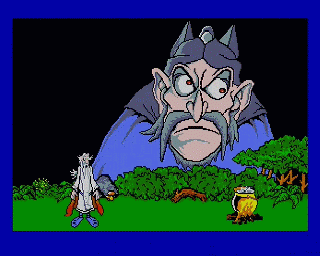
The game was released on many platforms with all versions being identical apart from a few having blue borders around the screen.
Quick Info:
|
Developer: |
|
|
Publisher: |
|
|
Designer: |
|
|
Genre: |
|
|
Themes: |
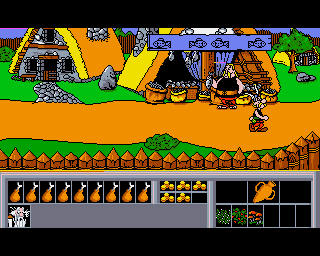
Astérix: Le coup du menhir (Amiga)
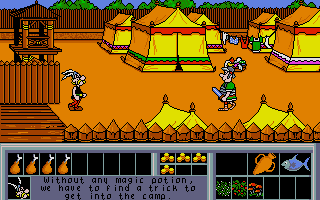
Astérix: Le coup du menhir (Amiga)
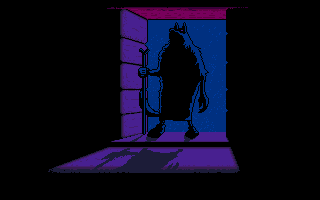
Astérix: Le coup du menhir (IBM PC)
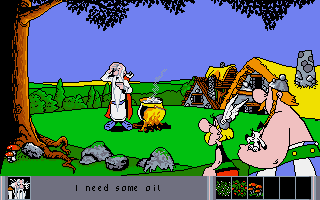
Astérix: Le coup du menhir (IBM PC)
In 1990 Astérix was finally out of the stranglehold of Coktel Vision's mediocre attempts, which time and time again felt stiff and unappealing. It was time to find a new home and a fresh take on the series. Luckily for Astérix, his new home would be one that knew exactly what to do with him.
During the late '80s to the early '90s, licensed properties had become a hot commodity. Franchises like Star Wars had for years proven that kids would pretty much die for anything with the likeness of their favorite characters or logos on it, and video games were no exception. For the most part these games were quick cash-ins which would sometimes have little to no clear similarity to the licenses it was based on, but Japanese developers such as CAPCOM, Konami and Sunsoft had acquired hot properties and put great efforts into the games they developed for them. CAPCOM had managed to snag the most valuable property of all, Disney, which led Konami to go on a hunt for other popular shows at the time to tie their name to. While the most famous of these titles would in the end be Teenage Mutant Ninja Turtles and The Simpsons, Konami would also manage to sign Astérix. This combination would turn to be a match made in heaven.
Astérix is a scrolling beat-em-up which takes the duo of Astérix and Obélix through all their most famous adventures. Running on the same engine as TMNT: The Arcade Game, Astérix offers some non stop action, with Roman soldiers being in seemingly never ending supplies and famous henchmen and villains making appearances at near every step you take. The style of game is a perfect fit for Astérix. The main draw of each comic and each movie was Astérix going on long journeys to beat up the bad guys, and all the humorous fights that would take place before reaching the main baddy. Konami didn't just throw this game quickly together, they really did their homework and the end result is that every character is represented authentically and never having a single questionable moment in the eyes of the fans. The graphics are probably the most colorful out of all the beat-em-ups that Konami would release and the art style is near identical to the artwork of Albert Uderzo, doing a better job at representing the product's look than the already stellar Ninja Turtles titles out. The animations, facial expressions and overall tone is faithfully represented, as Roman soldiers will fly into the air, lose teeth, get bruised and crawl out of the screen as our heroes run through them. After beating them, you can even collect their helmets for extra points. The main generic bad guys are the stock Roman soldiers and fat centurions, but as you progress onto the other levels you'll also find yourself fighting pirates, thieves and Indian guards. Astérix and Obélix have a plethora of moves at their disposal between them which is shown during the attract mode along with the controls, with one of the grabs being the iconic face slapping seen in Astérix et Cléopâtre (Asterix and Cleopatra)
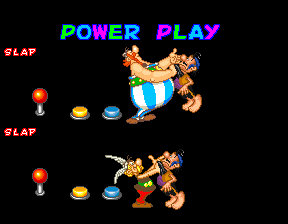
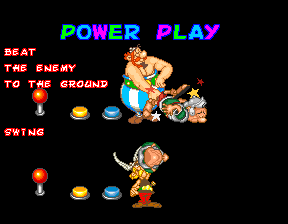
All the central characters make an appearance, some with special purposes. When you start the game, you will see all the villagers cheering you and fighting each other as they seem to be unnerved by the impending Roman forces outside of town. Panoramix will alert the players of Idéfix's arrival into the scene where he will bring along either a bottle of magic potion for Astérix or a roasted wild boar for Obélix. These items will instantly take out all enemies onscreen. At certain times you will also find Falbala walking around picking flowers. If the player gets in contact with her, they will receive a kiss which refills half your energy bar. At all these events, the enemies around you will actually react with either fear from your magic potion or jealousy of the kiss, further enhancing the presentation of the Astérix spirit found in the books and movies.


The levels are each based on different books in the Astérix series and contain signature places or objects from them, like the pyramids of Egypt, the flying carpet in India and the Circus in Rome. What really sets this game apart from the other similar games at the time are the level designs. Whereas TMNT and Final Fight would mostly just offer static left to right levels with the occasional elevator thrown in, Astérix features moments of platforming and other interactive pieces of scenery that makes the levels feel more alive than its competition. Jumping up the mountains of Spain or the booby traps in the pyramids really offers some good variety to keep things from getting stale. You even fly on the magic carpet over India just like in the book. Each stage has a nifty introduction which shows the original cover, along with a comic book style panel with our heroes entering the battle. In between some levels, you get bonus levels in the form of a chariot race (taken from a scene in Astérix et la surprise de César) or Barrel Break (takes place on the pirate ship which is a reference to the many times Astérix and Obélix destroy the pirate ship during their adventures).
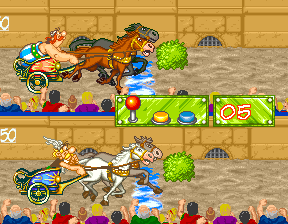
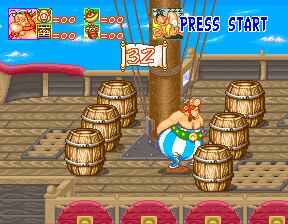
With the brilliant approach of basing each level on an individual book, you have the perfect setup to have the appropriate stage boss that fits with the book. Each boss is a well known character to the fans of Astérix. In Gaul you'll find the square formation Roman army, in Egypt the evil Amonbofis along with the hypnotist from Les Douze Travaux D'Astérix and in India you'll fight Kiwoàlàh on his magic carpet. While many would think towards the final boss being César himself, it's actually very rare for Astérix and César to directly fight each other. Throughout the entire series, César is shown as an aggressive but fair leader who has respect for the Gaul's courage to fight back, and will almost always follow up on his promises to correct things should Astérix be victorious in whatever challenge. So to make for a big epic final fight, you are put into the middle of the circus fighting tigers, gladiators and even the gladiator trainer himself, Briseradius. Once the good fight is won, César congratulates you and the Gauls return home to the village feast with Assurancetourix being tied up near the tree.

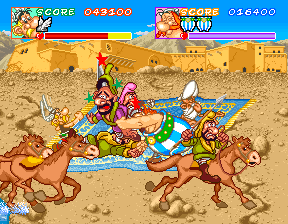
It really couldn't have been better than this- a superb developer with a deeply inspired take on a fan favorite franchise. It even gives a fresh take on the genre itself in addition to the license. The music is by the composer team of Mutsuhiko Izumi (TMNT: Turtles in Time), Michiru Yamane (Castlevania: Symphony of the Night), Mariko Egawa (Castlevania 64) and Junya Nakano (Dewprism). The music is quite catchy if not a bit stereotypical with generic cues attached to the different countries you visit. Unlike TMNT or The Simpsons, which had very famous musical elements which fans instantly would recognize, Astérix's movies had an ever changing soundscape to them and would never really sound the same. It did find itself a theme song called Astérix Est La (The Look Out Is Out) but apart from that there wasn't much of a signature Astérix sound. Despite this the music is at times quite excellent with Gaul Village and Credits standing out.
This game would never receive any home conversion, despite the popularity of the genre on SNES at the time. It would seem like a game that would really make sense to have a home port with 2 player co-op action and colorful graphics along with a recognizable name (in Europe at least) but maybe due to lack of strength in the US market, it never came to be. One reason for the lack of impact from this title, apart from the lack of real footing in the US, might be due to the fact that this game was only 2 players while other Konami brawlers prided itself on 4 or even 6 players simultaneously. But in the defense of Astérix, it really wouldn't make much sense to add more playable characters. Take the example of adding a Japanese wife to the mix of famous British rock bands, or even Elizabeth to the tag team of Hulk Hogan and Macho Man Randy Savage, it disrupts the dynamic of the well established team.
Sadly, despite being arguably one of the very best brawlers from Konami, it never made much of an impact and therefore is often overlooked and forgotten today. It still stands the test of time and holds up quite well today when other beat-em-ups might feel a bit static and plain. The authentic charm, humor and action found in the Astérix books is all here, and it's a game that every beat-em-up fan should play, and one that Astérix fans will surely love. To see further how it holds up compared to the rest of Konami's great catalog, the Konami Beat-em-ups article
Konami also developed a handheld LCD game based on this title. The goal remains virtually the same - take on Romans from all angles over 19 stages with difficulty ramping up per stage.
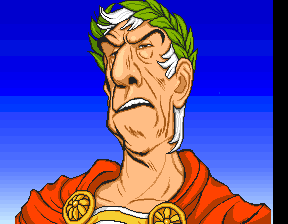
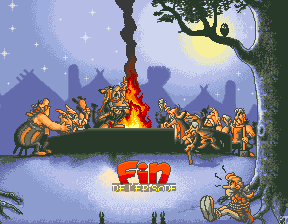
Quick Info:
|
Developer: |
|
|
Publisher: |
|
|
Genre: |
|
|
Themes: |
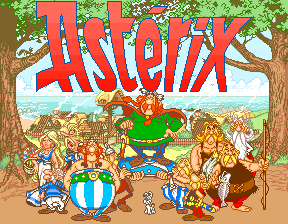
Title Screen
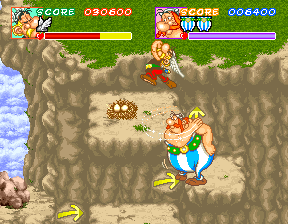
Astérix (Arcade)
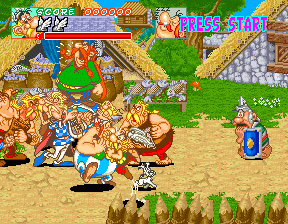
Astérix (Arcade)
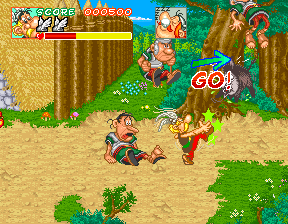
Astérix (Arcade)
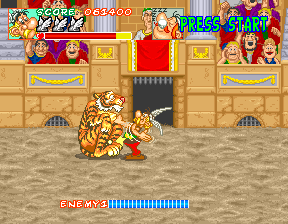
Astérix (Arcade)

Astérix (Arcade)
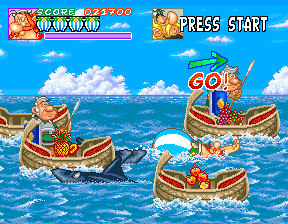
Astérix (Arcade)

Astérix (Arcade)
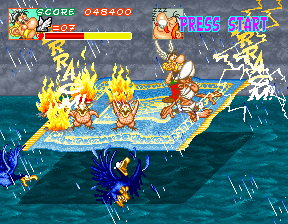
Astérix (Arcade)
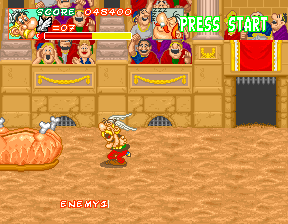
Astérix (Arcade)
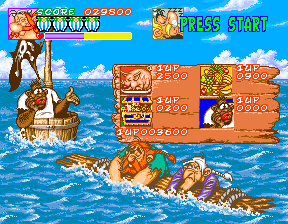
Astérix (Arcade)
Level Acts
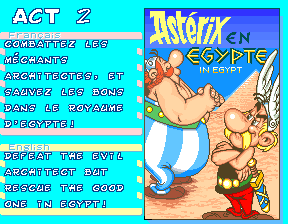
Act 2: Astérix in Egypt
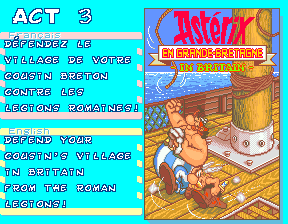
Act 3: Astérix in Britain
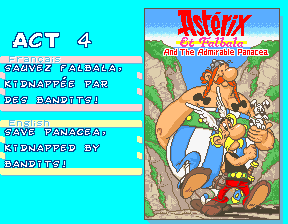
Act 4: Astérix and the Admirable Panacea
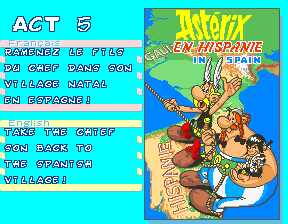
Act 5: Astérix in Spain
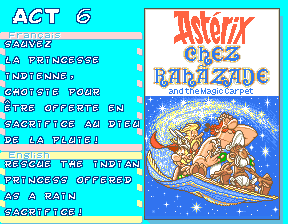
Act 6: Astérix and the Magic Carpet
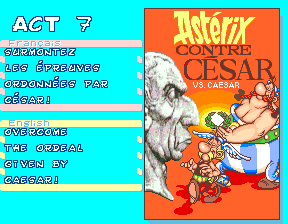
Act 7: Astérix Vs Caesar
1991 would turn out to be a great year for Astérix, as he wasn't honored with just one great video game, but two. Exclusively released in Europe and South America, this little title puts the French charmer on a home video game console for the first time. The system of choice was Sega Master System, a console that had a strong presence in Europe and Brazil. While the arcade game was done by Konami, this game was done by Sega of Japan.
Astérix is a side scrolling platformer, the kind the NES and Master System were known for. This time around Panoramix has been kidnapped, so Astérix and Obélix rush to the rescue in an adventure that will take them to caves, under the sea and finally the circus in Rome. The team behind this game was headed by Tomozou Endo, who earlier had worked on Michael Jackson's Moonwalker and Castle of Illusion Starring Mickey Mouse. The end result here is one of the finest platformers to be found on Master System. At the start of each round, you get the choice between either Astérix or Obélix, who both have pros and cons, and your choice affects more than just your abilities.
This game is told in a unique manner for its time. The duo actually splits up and take different routes, and the result is that depending on what character you choose, the level layout is altered or all together different from the other character. This makes the game essentially twice as long after first glance, and the levels remain individual until the last few level stretches in Rome, which are identical across the two heroes. All the levels are relatively short, but packed with tons of secret passages and items for you to find, as you have to search every wall for hidden treasures. Along the levels are also blocks which can be broken to find items and treasures. Astérix needs the magic potion or specialty items in order to break them while Obélix can punch through them without any assistance.
There are a lot of things that borrow from other popular games in the genre, especially Super Mario Bros. and Castlevania, which is an interesting mix. The first similarity you will notice is the wells. Certain wells along the road will allow you to sink down and access secret underground sections, where you can collect coins and other valuables. This is obviously a very famous element from Mario games. The similarities to Castlevania show in the way items are used. Both Astérix and Obélix can pick up items that help them get rid of baddies quicker, and these are mostly potion based. These potions are small bottles thrown in front of you which expands and creates a small field of deadly spread, very similar to the holy water found in Castlevania. The map screen and level layout also bears some resemblance to Castlevania, as do the enemy patterns.
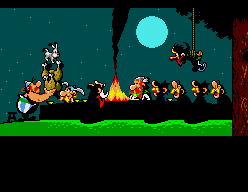
The levels and layout are all trademark platformer material. There are forests, ice caves, fire caves, and pyramid mazes. At one point you even swim through the Roman sewers, which must be the most disgusting idea for an underwater level of all time. The travel aspect to the level layout is very much in line with the usual Astérix way of adventure and never feels out of place nor does the level succession feel forced. On most levels the main objective is to find a key that unlocks the door to the boss battles (similar to Power Blade on NES). Bosses sometimes change depending on what character you have chosen, but most of them are pretty simplistic and simply jump around in a specific pattern and are disposed of quite easily. One interesting boss is a trio of midgets that jumps out of holes, leading you to play a game of whack-a-mole in order to defeat them. This game doesn't make much use of characters from the actual books and relies more on generic Romans, various animals and vikings to be the obstacles of your journey. They did manage to get some well known things included such as the tree-stump-disguised Romans in the Gaul forest. After each round you get a bonus level where Idéfix has to jump on bubble to bubble in order to get points. This marks the first time players could control Idéfix in a video game. The last level also offers a break from the usual platforming with the horse chariot race making a return.
The graphics and music are some of the best offered on the Master System. Graphically it does stray a bit from Uderzo's usual look but in exchange we get to see a chibi-esque take on the franchise which fits quite well. Sega would again opt for this style in their Ghostbusters game on Genesis, which actually bears some resemblance to this game. All the levels are bright and colorful and offers something new in order to keep the game from feeling stale after longer play sessions. The music was composed by Takayuki Nakamura who would go on to become a prolific composer, scoring games like Virtua Fighter, Ehrgeiz and Lumines. The melodies are quite good, but none of them really hit any peak and lack a certain punch compared to what you would find in the Astérix arcade game. That said, it still holds up a certain charm and good vibe.
Despite being only released in Europe and Brazil, this is a game that should be in any serious Master System collection. It's not just good when comparing it to other Astérix games, it's good when taking the whole console library into account. It offers excellent platforming action, solid amounts of treasures and secrets to find, great controls, good music and tons of replay value.
Quick Info:
|
Developer: |
|
|
Publisher: |
|
|
Designer: |
|
|
Genre: |
|
|
Themes: |
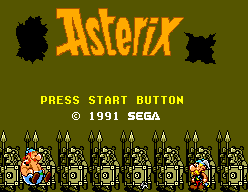
Title Screen
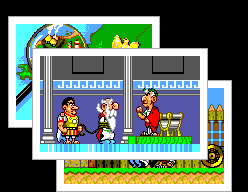
Astérix (Master System)
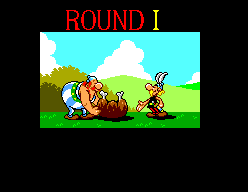
Astérix (Master System)
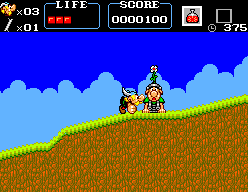
Astérix (Master System)

Astérix (Master System)
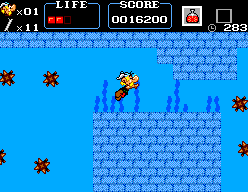
Astérix (Master System)
Following excellent reviews and success with Astérix one year earlier, Sega decided to make a sequel. Panoramix is again been kidnapped by César and the Romans, but this time they also took Idéfix with them! Naturally this means war, so Astérix and Obélix once again brings along some potions and wild boar as they search for the druid and their beloved dog. While Astérix on Master System was developed internally at Sega of Japan, this game was handled by British studio Core, who would later help soil many pants with the release of Tomb Raider.
Sadly at this point in time, the only thing Core could soil was the Astérix name. Like the prior title, this game takes you on a journey through Gaul and Europe in the fight against Romans and rabbies infested animals of all kinds in order to save Panoramix and Idêfix who are held captive in Rome. Three versions were made and the game was released on all available Sega consoles at the time. Though it is stated across various sources on the internet that the Genesis/Mega Drive was released first, this is in fact wrong. The Master System version was released near one year prior to its 16-bit brother in late 1992, though this was only true for certain parts of Europe. Between the Master System and Genesis, the games have a great number of differences.
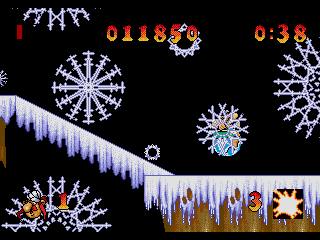
Astérix and the Great Rescue (Genesis)
The Master System version plays somewhat similar to its predecessor - a straight forward platformer with Astérix avoiding all kinds of dangers from the animal kingdom to Mother Nature herself trying to throw hazards at the size handicapped Gaul. There are five zones which are divided into separate small levels, with each having a specific theme to it, like Gaul, Forest or Rome. By default you start as Astérix but by pressing up and 1 you change into Obélix, which makes it stand out a bit from other platform games. There's very little reason for changing into Obélix, however, as he is big, burly and has little reach with his attacks, while Astérix can crawl, jump higher and his punch has a longer reach. The attacks are a major problem because both characters have only one punch, which enemies have to be right next to you in order to connect. You can hold down the button to do a charge attack, but it does little good as you are most likely going to take damage before it will connect. There is also no attack while jumping or ducking, another big problem as many times enemies are above or below, you which forces you to take damage before being able to take them out. All the graphics are alright, but they lack color and vibrancy, making it into a real bummer of a look. The levels also feels incredibly unoriginal and could have been put into any game without it making any difference. In the end, it feels nothing like Astérix and looks more like McKids than the French comic. A Game Gear version saw release some time later, which is a direct port of this version with no changes except a smaller screen.
The Genesis version is another beast in itself - an ugly and grotesque beast at that. While retaining the story line and most of the level designs, this version works quite differently. The biggest change is the fact that you now control either Astérix or Obélix depending on your choice before the stage. The same rules apply to their abilities, however, and there is little to no point in picking Obélix, even more so in this version. The attack range is as horrible as ever, and enemies will walk into you constantly while you try to attack, usually without much luck. You can find items to help you, like bombs and cloud platform bottles, but they come in a limited supply of three at a time, and won't be of much help. The game is excruciatingly difficult as well, and everything is out to get you. Roman guards march onto you from every angle, birds go flying at 200mph, snowmen slide over your feet, crabs pinch you, it is clear Astérix pissed off the Gods, because all of his creatures are out to get him. You still can't jump and attack leading to you taking so much damage that you're not likely to see the end of the stage before throwing the controller like Zeus throws lightning. The stage layout has been drastically changed to make it accessible for both characters, but they still look awfully bland and looks like something out of any generic platform game. The graphics do have a more colorful look in general, with a similar look to Dragon's Lair on SNES. One level of particular interest is the snow level, where snow flakes that covers half the screen fall constantly, blocking your field of view.
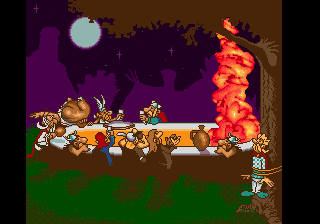
Astérix and the Great Rescue (Genesis)
The music is, however, a different story. Composed by Tomb Raider's Nathan McCree, most the tracks are top notch. Getting more than he should out of the YM2612 FM chip and delivers some solid tunes, with the title screen standing out among them. The music doesn't really fit well with the stages nor the overall style of Astérix, but like everything else here, it's all just a mix of things thrown together which doesn't fit, so the music is at least a highlight. In a way, the music has that distinct European demoscene feel to it, which you would find in Chris Hülsbeck and Bjørn Lynne, though the compositions are not as strong as what they would have offered. The Master System soundtrack is overall good too, though more low key and the melodies are less bold.
Sadly, this title was the first Astérix game to get a solid worldwide market release with the exception of Japan. It seemed as if everything was there to make this into a great introduction for new fans and a title for old hungry fans to come back. The prequel was excellent, the license and source material is strong and hugely inspired, yet what we got in the end is a generic platformer with horrendous controls and stock level layout. Worst of all, it lacks all the humor and vibes found in Astérix. It's alarming that Japanese developers who never had much connection to Astérix could get the mood and feel down near perfectly, while a developer from the UK, a territory in which Astérix was hugely popular, misses the mark so completely.
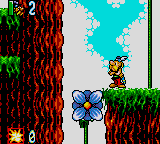
Astérix and the Great Rescue (Game Gear)
Quick Info:
|
Developer: |
|
|
Publisher: |
|
|
Designer: |
|
|
Genre: |
|
|
Themes: |
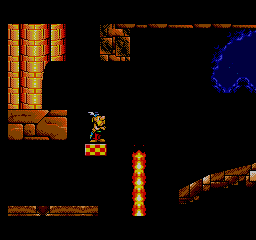
Astérix and the Great Rescue (Master System)
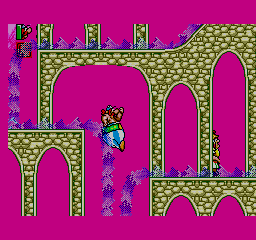
Astérix and the Great Rescue (Master System)
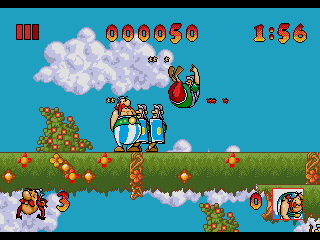
Astérix and the Great Rescue (Genesis)
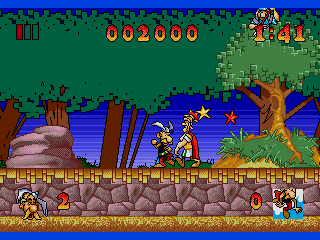
Astérix and the Great Rescue (Genesis)
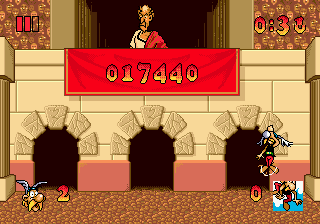
Astérix and the Great Rescue (Genesis)
Screenshot Comparisons
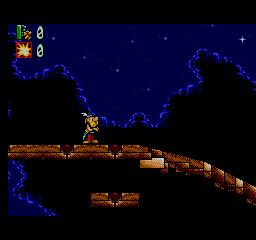
Master System
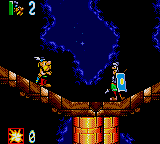
Game Gear
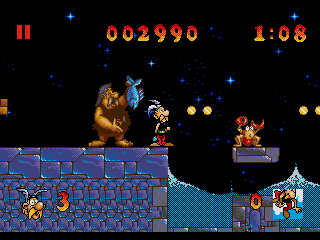
Genesis
It's almost amazing to think about, but Astérix games had been steadily released since the early '80s, yet it would be as late as 1993 before any of them graced a Nintendo console. To make up for this puzzling absence, French publisher Infogrames released their new Astérix game on all Nintendo consoles at the same time. Developed by Spanish Bit-Managers, each game would be different from each other while sharing the same basic storyline and setup. This time around it's Obélix that has vanished from the village! So it's up to Astérix to rescue his lifelong best friend before the Romans throw him to the lions.
The NES version takes a page out of Sega's book and returns to the more simple and colorful look of 1991's Astérix on the Master System. The locations are vibrant, the mood is more upbeat and the punch has thankfully a wider reach. You visit four acts, which take you through Gaul, Helvetia, Spain, Egypt and Rome, with each having 3-4 levels within them. Each of these worlds offer staple hazards from the platforming genre with ice making you slide, boulders crashing down on you and massive amounts of fire jumping around the ground for you to avoid. The enemies range from Romans to Egyptian soldiers, but the majority of enemies you face are actually from the animal kingdom - sparrows, piranhas, snakes, spiders and, of course, wild boars. It might sound like this game is going in the same direction as Astérix and the Great Rescue, but in reality it's actually quite fun...and damn funny, in fact. It's aimed at younger gamers so the difficulty isn't suffocating, but it still packs a challenge with some good level designs and accurate controls to guide you along. On all the stages you'll find big A blocks which can be punched in order to get stars for points or other secrets. You can also find a magic potion bottle which gives you invincibility for a short run. After each act, you also got a bonus round, which is either you breaking barrels thrown at you by a pirate, or log rolling at sea. There aren't any bosses to be found outside of the last boss, Briseradius.
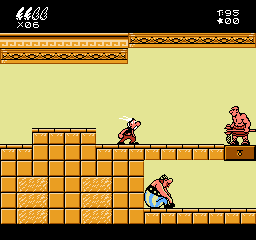
Astérix (NES)
What really makes this game stand out is the soundtrack. Alberto Jose González had formerly worked on minor titles on the ZX Spectrum, MSX and the Amstrad CPC but this would be his first soundtrack for a big title on the world's best selling home console of all time. His debut couldn't have been any better, as the soundtrack pushes the NES sound chip in a new highly fresh direction. With inspirations from Tim Follin, David Whittaker and Ben Daglish, it offers a sound somewhat reminiscent to titles like Solstice. It's an insanely catchy soundtrack with unusual percussion elements, groovy bass and feet tapping melodies. It also offers almost unrivaled emotional content for an NES soundtrack. The Game Over theme is one of the most cerebral tunes you will find on the console, and the Credits is has a great sense of reminisce going for it. Whether or not the game itself tickles your fancy, the soundtrack is of such quality that it becomes a must have for that alone and stands up with the very best of what the NES has to offer. Gonzales would go on to score numerous Astérix games for Infogrames and also handle other franchises like The Smurfs, which are some of the most amazing game music unheard by most gamers.
Astérix on Game Boy was released near simultaneously with the NES version and plays very similarly. The locations, enemies and order remains the same but in order to make up for the smaller screen, the layout is completely changed to make it more portable friendly. The backgrounds have also seen a change and boasts more detail than its NES counterpart. They even added bits of parallax scrolling to the background, which is impressive, though the use of it is minimal and doesn't distract nor really catch your eyes often. The difficulty in terms of enemy behavior and patterns are easier here, and there seems to be more extras to be found to further give gamers a slight break, but the controls are strangely unresponsive at times, especially when it comes to jumping. It's a shame that the controls would take a hit, because it had quite a bit of potential, and at times feels similar to Super Mario Land. Gonzales is the man behind the soundtrack on this version as well, and it is changed up with a few new tracks. The game sounds fantastic on headphones, though it feels like it plays more by the rules of the genre, while the NES version has a bit more of an experimental sound.
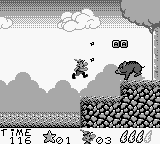
Astérix (Game Boy)
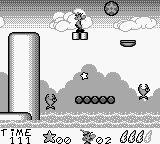
Astérix (Game Boy)
The Super NES version differs greatly from the 8-bit versions in a number of ways. Following the same story of rescuing Obélix, all the stages have been redone, the graphics have gotten a major boost and the game is much much longer than any of the 8-bit games. Developed internally at Infogrames, it feels quite different too as Astérix controls somewhat heavier than before. He is also considerably slower, and that is the flaw that really brings this game down. Astérix's jump is exceptionally slow and will usually not reach over to your preferred landing location. You can do a running jump to gain more air but the run takes too long to get up in speed, leading to many frustrating deaths, often from falling into pits because your jump simply did not reach.
The levels looks vastly different too, and acts more like an open playing field for you to find the exit instead of just simply walking left to right. Some stages drag on for way too long, and there is no password or save feature, so it's quite a chore to get through all 50 of them and find the often non apparent exit. A few new items have been thrown in, such as the green magic potion which lets you fly Mario 64 style with the wings on your helmet. You can also find bones to call Idéfix in and take out some Romans on screen, or a lyre so Assurancetourix flies in on a cloud and freezes everything on screen. The enemies are the same bunch of angry animals as before. It's such a puzzling choice to resort to unoriginal animals when in the comics Astérix fights such a wide arrange of different characters. It seems so lazy by the programmers to just make Astérix punch defecating crows and porcupines. The art style is also somewhat strange, with some enemies and backgrounds being fittingly cartoony and colorful to suddenly seeing others drawn in a photo realistic style as if they were just taken from another game. Astérix himself looks good, at least. The ending is also one of the biggest anticlimaxes in game history as you simply find Obélix sleeping in the middle of the last level. No end boss, no last obsticle, just walk over him and fade to the ending. The music was not handled by Gonzales but by Alone in the Dark composer Frédéric Mentzen. It's good with some good bass lines keeping it interesting, but doesn't come close to what Gonzales scored for the NES and Game Boy.
The SNES version was planned for a US release in 1994 but was cancelled despite ads popping up in game magazines. While no reason has ever publically been given, it's a good guess that Electro Brain, the planned publisher, just didn't believe in the name value of Astérix to sell in the US. None of these titles redefine the platforming genre nor do they screw them up entirely. It doesn't really retain any of the humor from the Astérix comics or movies but in the case of the 8-bit releases, you get two fun easy to pick up and play games with some fantastic music.
These games started a unique promotional deal where if one purchased either version of the game, the box could be taken to Parc Astérix for a free day pass. Most releases throughout the mid '90s would use this marketing tool. They usually expired by the end of the release year.
Quick Info:
|
Developer: |
|
|
Publisher: |
|
|
Designer: |
|
|
Genre: |
|
|
Themes: |
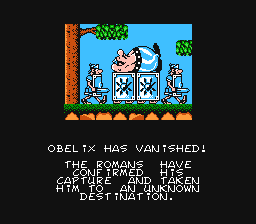
Astérix (NES)
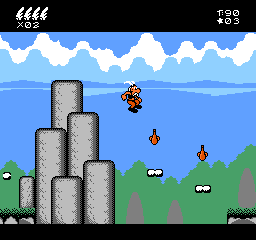
Astérix (NES)
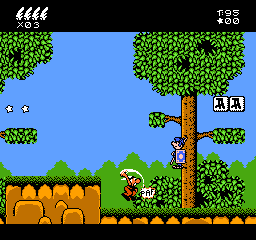
Astérix (NES)
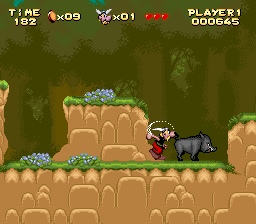
Astérix (SNES)
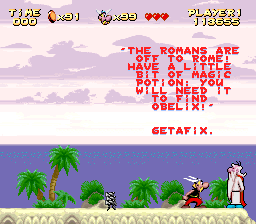
Astérix (SNES)
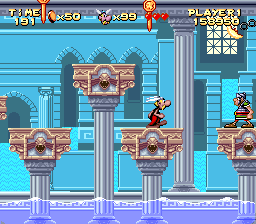
Astérix (SNES)
Screenshot Comparison
After the mixed results offered on the Nintendo platforms, it was time for Astérix to return to the console where his greatest adventures so far had taken place - the Master System. Tomozou Endo returned as a consultant and Sega of Japan once again handled the franchise in order to once again do it justice. Astérix and the Secret Mission was released in the last stretch of the Master System's mainstream life.
Panoramix informs the heroic Gaul duo that disaster has struck - he has run out of the necessary herbs needed to brew the magic potion. Astérix decides to go on a secret mission to seek out the herbs worldwide so that César does not catch ear of the news and invades the village. But Obélix finds out his friend has just left and trails behind. Within this story elements lays the layout of the game. While the environments are the same ones we have explored in the earlier titles - Egypt, Rome, Gaul forest and the like - this game takes the dual character layout scheme from the first Master System title and greatly expands upon that feature. Astérix and Obélix play differently from each other with a different moves sets and strengths. Astérix relies on potions that are found lying around. The effects of these potions vary but the all share the common effect that Astérix can punch through blocks. Depending on its color, these potions can also create fields of fire and shrink objects. Astérix also has a dash and a pretty useful double jump which can be used to reach high areas and pass deadly gaps. Obélix doesn't use any potions or power ups thanks to his permanent state, but he is much stronger, can slide down slopes, throw menhirs and perform a ground pound to break blocks and kill enemies. Basically, Obélix plays almost exactly like Mario.
This game cleverly tells its story almost completely through the gameplay. Astérix and Obélix take two separate routes to look for the herbs and therefore their levels are completely different though happen at the same time. A prime example of this is during the second level. If you pick Astérix, you will go surfing to reach the deck of the haunted Roman gallion since he hates being in the water. Obélix will go underwater and swim there before eventually going inside the boat. All the levels are different depending on your choice except Rome, as the cut scene before that stage shows our heroes meeting up again. Rome still has small difference to play to the character's strength and abilities.
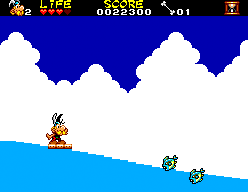
Astérix's Route
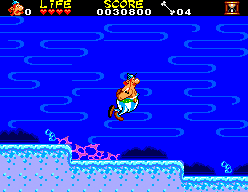
Obélix's Route
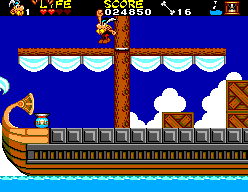
Astérix's Route
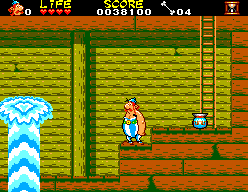
Obélix's Route
Sega did an outstanding job at making the visuals look incredible. The art style still uses the chibi styled framing of the characters, but they retain more of the expressions and style of movement that you would find in the comics. The game is loaded with bright colors, and each background looks and feels unique from the other, while they all fit into what one would expect from an Astérix adventure. On each stage you can find various items like roasted boar to refill your health, bones to use on a Idéfix minigame and feathers for extra lives. Graphically it looks and feels so sharp it really rivals the look of many earlier Genesis games, and certainly looks better when you factor in the appropriate use of the art direction. The controls feel responsive and all the moves are easy to pull off with no great issue ever arising. Astérix's double jump sometimes doesn't really have the desired height one might have been hoping for, which leads to some falls into gaps, but the game is quite generous with extra lives and checkpoints. In fact the entire game is a pushover and veteran gamers will probably go right through it on first playthrough. Luckily it's a really fun and charming game. The music was done by Katsuhiro Hayashi and is great, though not earth shattering by any means.
A Game Gear version was also released though with no changes made to the game besides the zoomed in view to make up for the smaller screen. However a special box set was released for this version around Christmas of 1994 dubbed the Astérix 35th Anniversary Box which included a t-shirt and the Game Gear game in a nice looking box with exclusive art from Uderzo. This is now a sought after collectors item.
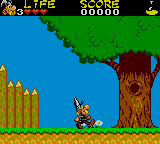
Astérix and The Secret Mission (Game Gear)
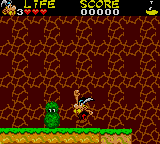
Astérix and The Secret Mission (Game Gear)
In Brazil, this game was changed into As Aventuras da TV Colosso, based on a puppet show from Brazil which was quite popular during the '90s and still remains dearly loved today. I lived there in 2007 and it was still running in syndication with talks of a reboot being discussed. The boss of the channel is sick, and to be cured he'll need a medicine made up from six rare herbs. But they can only be found in the wilds, and get them is a mission for Gilmar and Priscila, the lead characters. Graphics were slightly altered to make the enviorements more modern and characters changed to reflect the show's cast. Most of the game remains just the same.
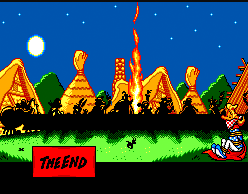
Quick Info:
|
Developer: |
|
|
Publisher: |
|
|
Genre: |
|
|
Themes: |
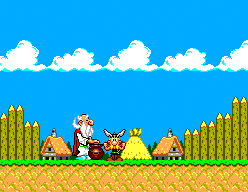
Astérix and The Secret Mission (Master System)
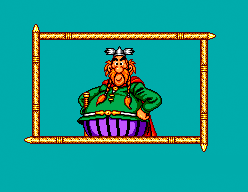
Astérix and The Secret Mission (Master System)
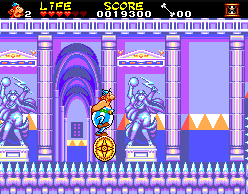
Astérix and The Secret Mission (Master System)

Astérix and The Secret Mission (Master System)
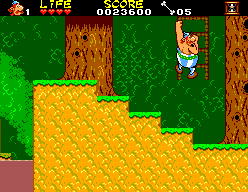
Astérix and The Secret Mission (Master System)
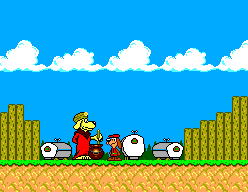
As Aventuras da TV Colosso (Master System)
Version Comparisons
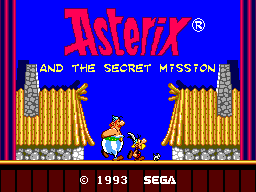
Astérix and The Secret Mission
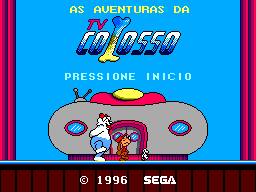
As Aventuras da TV Colosso
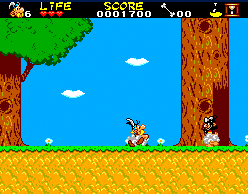
Astérix and The Secret Mission
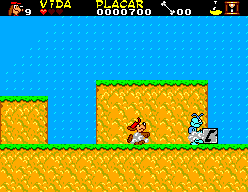
As Aventuras da TV Colosso
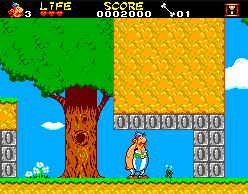
Astérix and The Secret Mission
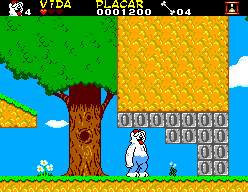
As Aventuras da TV Colosso
Game Gear 35th Anniversary Christmas Box Set
|
Page 1: |
Page 2: |
Page 3: |
Page 4: |
Page 5: |
|
Page 6: |
Page 7: |
Page 8: |
